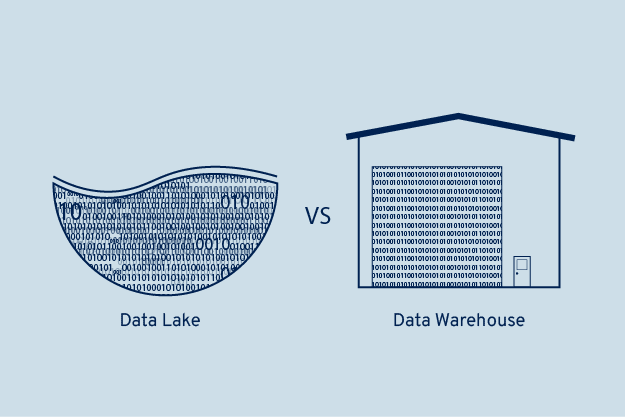With the conversation growing around data lakes, a common question has arisen within the industry: what are the differences between a data lake and a data warehouse? The difference between a data lake vs data warehouse is this: a data lake holds data of diverse, often unstructured types and formats, and is used for discovering and modeling meaningful relationships among data; whereas a data warehouse is predominantly structured and optimized for gaining insights from data that is already understood and for making data accessible to established business processes and reporting. The two design types are becoming mingled, for example with the emergence of data lake houses, which are structured data schemas/warehouses within a data lake.
When looking to compare the key differences between data lake vs data warehouse architectures, it is useful to understand both the uses and limitations of the ubiquitous data warehouse design. The data warehouse came into being as an analytics and reporting enabler that would consolidate business operations data into a single data store, de-normalizing (consolidating data groups into single larger entities) it under more business-like naming structures.
Data warehouse use cases
- Good for Reporting and summarizing data from multiple operations platforms
- Good for performance, with its star-schema modelling and isolation from operational data processing
- Designed to allow multi-dimensional analytics and time-series rollups
Data warehouse limitations
- Processed data only (typically via other upstream systems) – often the data lineage and processing rules are not known to the end data users.
- Limitations to the ability to perform “what if” analysis unless source data and lineage are known
- Data enrollment requires a level of validation and transformation (via the traditional extract, transform, load, ETL, approach) before it can be analyzed
- Data loading typically is processed in arrears of operational processing, often meaning a reliance on daily batch jobs and the prospect of data staleness.
- Cross organizational reporting is often difficult to achieve, data warehouses are often workgroup or business unit based.
Data Lake and Lake House
The Data Lake and, latterly, Lake House concepts came about to include the data warehouse benefits and to help address the limitations inherent in the traditional data warehouse design, by enabling both raw and processed data to reside together, along with strong data lineage identifying data transformations into different lake layers within the lake (e.g. bronze – raw, silver – structured, gold – curated). This allows the end user to understand any business transformations and apply “What if” analysis as required.
Also, by changing from an ETL to an ELT (extract, load, transform) paradigm, data enrollment becomes easy and fast, as all the data can be loaded prior to any validation steps, guaranteeing instant data access and accelerating time to value in the Lake.
Data lakes allow for large, disparate and diverse groups of data to be loaded and then refined, linked and analyzed as required – also satisfying all reporting requirements. Data lakes are typically deployed at organizational level and leveraged highly for risk analytics, profit/loss and regulatory reporting purposes, across the firm or institution.
Other benefits from a data lake based architecture include:
- One platform across an organization, simplifying data extraction, reducing “data hops” to final report/solution and minimizing the required cross organization toolkit
- Resources from app-stores that are purposed to accelerate data curation and extraction within the lakes
- Big data processing and in-memory data cubes allow for accelerated data access and in-built, self-optimization in the processing framework.
Data lake designs will continue to evolve and a key success factor for any business that adopts one will be the speed at which their lake can make use of data that is being brought into it.
Find out how to get faster value from the data that you’re putting into your data lake. Contact us


